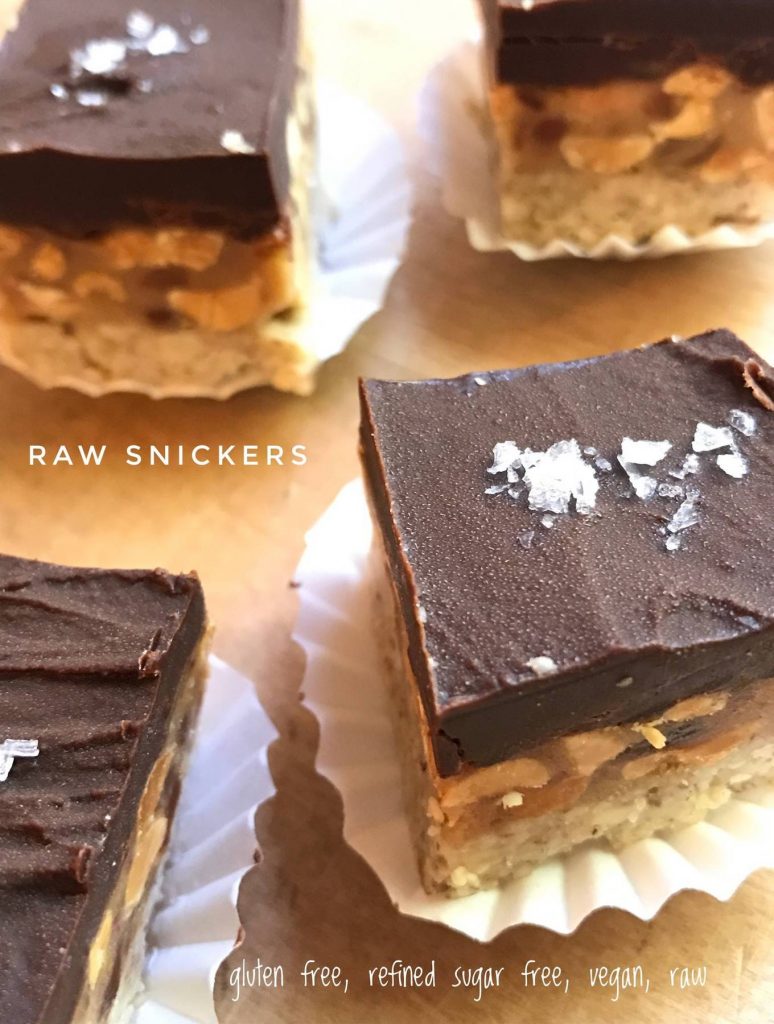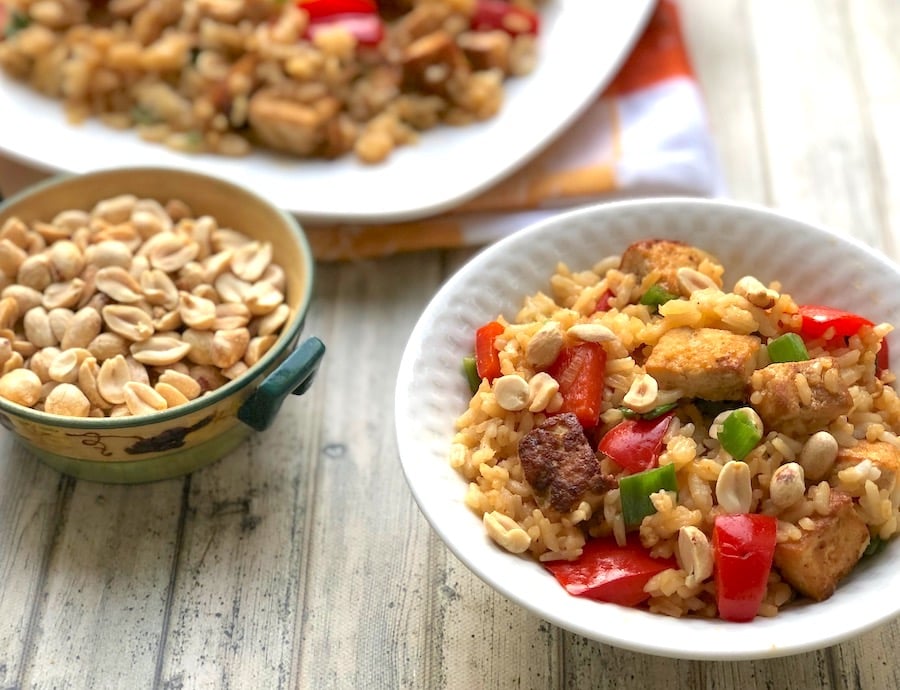Here’s a concise guide to peanuts — with tips, uses, and easy vegan recipes for America’s favorite nut. Inexpensive and high in protein, peanuts are also highly versatile as a pantry staple.

Not only are peanuts the most widely used nuts in the United States (Americans daily consume millions of pounds of peanut products, including peanut butter), but they’re also well loved in African and Southeast Asian cuisines. If you’re a peanut fan, the National Peanut Board has some fun facts for you.
Botanically, peanuts are actually legumes, as they grow from a vine-like plant, unlike tree nuts. The pods containing the peanuts grow underground, hence their archaic name groundnuts. However, the appearance, flavor, and ways of using peanuts are more closely related to nuts than to legumes, so for all practical purposes they can be classified together.
There are several varieties of peanuts. The two most common are the familiar jumbo, or Virginia, peanut and the smaller, red-skinned Spanish peanut.
A bit of peanut lore
Peanuts are believed to have originated in South America several thousand years ago. Carried back to Spain and Portugal by early seventeenth-century explorers, peanuts came to North American via the African slave trade in the nineteenth century.
George Washington Carver, the noted American botanist, is widely credited with popularizing the use of peanuts in this country by devising and promoting hundreds of recipes.

Major allergy alert
As we know, peanut allergy can be very serious. Consult your practitioner if you suspect an allergy; and if you know that’s the case for you or someone in your household (especially kids), avoid peanuts completely.
Buying and storage
Peanuts are generally the most economical nuts you can buy, especially when purchased in the shell by the pound. When buying shelled peanuts, your best bet is the dry-roasted, unsalted variety.
The flavor of peanuts is much improved by roasting. In fact, peanuts should never be eaten raw. They contain a substance (easily destroyed by roasting or even cooking) believed to interfere with the body’s ability to absorb nutrients.
Unshelled peanuts will stay fresh for several months if kept in a cool, dry place, but if you have a large quantity it’s best to refrigerate them during warm weather. Shelled peanuts will keep under cool, dry conditions for 2 months; if stored longer than that, they should be refrigerated.
Peanut nutrition
Peanuts are 49 percent fat. Most of the fat is monounsaturated, with some polyunsaturates and very little saturated fat. Peanuts lead most other nuts in protein content, at 26 percent.
1/4 cup of peanuts contains about 200 calories, 18 grams of fat, and 9 grams of protein. Peanuts provide generous amounts of many minerals, including magnesium, phosphorus, and iron; they are particularly rich in potassium. Of the several B vitamins they contain, they’re particularly high in niacin. Here’s the complete nutrition profile of peanuts.

General uses for peanuts
Versatile peanuts have a wide variety of uses in cooking and baking:
A baking nut: Use chopped peanuts as a more economical substitute for walnuts in brownies and cakes.
Stir-fry topping: Add peanuts to stir-fried vegetables just before serving, but don’t incorporate them into the dish if you anticipate leftovers, since the peanuts will become mushy by the next day.
Grain and noodle topping: Top simple rice and other grain dishes with a handful of peanuts halves. Finely chopped or coarsely ground peanuts are a classic topping for Asian noodle dishes like Pad Thai.
Gorp and trail mix: Combine equal parts peanuts and raisins for a simple snack, known as “gorp” (good old raisins and peanuts). Use peanuts in other dried fruit-and-nut trail mixes.
Salad embellishment: Add peanuts to fresh green salads. Combine greens such as spinach and romaine lettuce with cooked corn kernels, sprouts of any kind, and diced tomatoes. Toss in a handful of peanuts and dress with vinaigrette dressing.
Nut meal: To make a nut meal, place 1/2 to 1 cup roasted peanuts in the container of a food processor. The trick is to stop processing the minute they’re finely ground, otherwise, you’ll be well on your way to peanut butter (coming up next!). Make only as much as you need, since grinding releases a lot of oils. Peanut meal adds a rich flavor to cakes, breads, and pie crusts. Simply replace 2 to 3 tablespoons of each cup of flour in a recipe with peanut meal. Or, before baking, sprinkle peanut meal over cakes, breads, and muffins as a nutty garnish. Peanut meal can also replace or be combined with bread crumbs as a topping for casseroles.

Homemade peanut butter: Making nut butter at home is surprisingly easy, and a fun project for kids (who aren’t allergic to peanuts, of course). Start with 1 cup of dry roasted peanuts in a food processor. Process until the peanuts are finely ground into a meal and begin to hold together as a mass.
Add a tablespoon of agave or maple syrup and continue to process, stopping the machine and scraping down the sides from time to time, until smooth. Add a pinch of salt, if you’d like.Transfer to a tightly lidded jar. Keep at room temperature for about a month; if the homemade peanut butter is to be stored for a longer time, refrigerate. Bring to room temperature before using.
Recipes using peanuts

Chocolate Peanut Butter Pie: This richly flavored no-bake vegan chocolate peanut butter pie also used crushed peanuts as a topping. It’s a luscious high-protein dessert created by Robin Robertson. Bonus — it’s gluten-free.

Vegan “Snickers” Bars: Gluten free, refined sugar-free, and raw, these peanut-y vegan “Snickers” bars have a number of steps but aren’t difficult to make.

Vegan Chocolate Chip Peanut Butter Blondies: If you love peanuts (and aren’t allergic!) add peanut halves to the peanut butter batter for a double dose of nutty flavor.

Thai Vegetable Stew with Coconut-Peanut Sauce: Another double peanut recipe — a peanut butter-based sauce and a garnish of peanuts. A delicious Asian-style main dish!

Spicy Peanut Noodles with Zucchini and Tomatoes: Here’s a super easy and tasty take on spicy peanut noodles. Use bottled peanut satay sauce or make your own, but either way, top with chopped peanuts.

Teriyaki Fried Rice and Tofu: This simple fried rice and tofu dish, embellished with peanuts, is a sturdy, everyday kind of weekday dinner main dish.
See more of this site’s Good Food Guides.


Leave a Reply